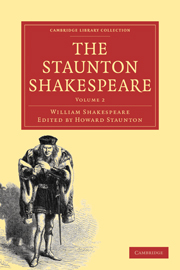Book contents
- Frontmatter
- Contents
- ALL'S WELL THAT ENDS WELL
- KING HENRY THE FIFTH
- AS YOU LIKE IT
- PERICLES, PRINCE OF TYRE
- TWELFTH NIGHT; OR, WHAT YOU WILL
- THE FIRST PART OF KING HENRY THE SIXTH
- THE SECOND PART OF KING HENRY THE SIXTH
- THE THIRD PART OF KING HENRY THE SIXTH
- TIMON OF ATHENS
- KING RICHARD THE THIRD
- MEASURE FOR MEASURE
- KING HENRY THE EIGHTH
- CYMBELINE
TIMON OF ATHENS
Published online by Cambridge University Press: 29 August 2010
- Frontmatter
- Contents
- ALL'S WELL THAT ENDS WELL
- KING HENRY THE FIFTH
- AS YOU LIKE IT
- PERICLES, PRINCE OF TYRE
- TWELFTH NIGHT; OR, WHAT YOU WILL
- THE FIRST PART OF KING HENRY THE SIXTH
- THE SECOND PART OF KING HENRY THE SIXTH
- THE THIRD PART OF KING HENRY THE SIXTH
- TIMON OF ATHENS
- KING RICHARD THE THIRD
- MEASURE FOR MEASURE
- KING HENRY THE EIGHTH
- CYMBELINE
Summary
“The Life of Tymon of Athens” appeared first in the folio of 1623. At what period it was written we have no evidence, though Malone assigns it to the year 1610. The story, originally derived from Lucian, was a popular one in Shakespeare's time, and must have been known to him from its forming the subject of a novel in Paynter's “Palace of Pleasure,” and from the account of Timon given in North's translation of Plutarch. The immediate archetype of the play, however, was probably some old and now lost drama, remodelled and partially re-written by our author, but of which he permitted much of the rude material to remain, with scarcely any alteration.
It is upon this theory alone we find it possible to reconcile the discordance between the defective plan, and the faultless execution of particular parts,—between the poverty and negligence observable in some scenes, and the grandeur and consummate finish displayed in others. The basis of Shakespeare's “Timon” was long supposed to be an anonymous piece, the manuscript of which was in the possession of Mr. Strutt, and is now the property of Mr. Dyce. But this manuscript was printed, in 1842, for the Shakespeare Society; and although it is found to have one character, Laches, who is a coarse counterpart to the faithful steward, Flavius, and two or three incidents, particularly that of the mock banquet, where the misanthrope regales his parasites with stones, painted to look like artichokes, which correspond in some measure with transactions in the piece before us, there is not the slightest reason for believing Shakespeare ever saw it.
- Type
- Chapter
- Information
- The Staunton Shakespeare , pp. 457 - 508Publisher: Cambridge University PressPrint publication year: 2009First published in: 1859

